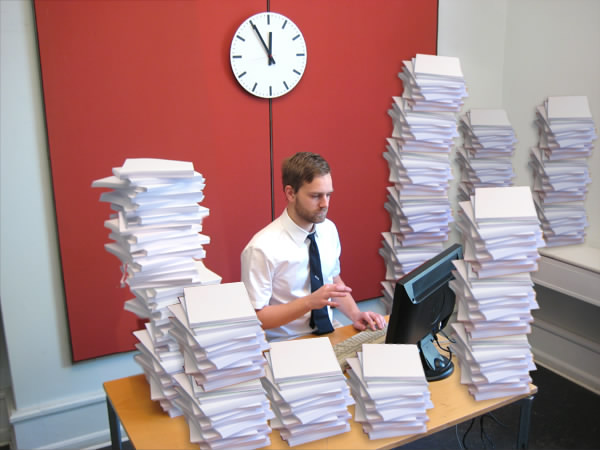In the first part of the series on getting organised, we learned how we need a place for everything and that everything should be in its place. Today, we learn about another common problem that comes in the way of staying organised, i.e. pile up. Things or activities keep piling up. Due to overwhelm, we let them pile up and do not deal with them. By the time we decide to do something about the pile, we have a huge backlog. Here’s how to systematically deal with pile ups or better yet, not let things pile up in the first place.
What is a pile-up?
Without getting into jargon, let’s describe examples of piling up. If you do not read your emails regularly, they pile up in your inbox. Soon, you will have pages and pages of unread emails. If you do not wash your utensils soon after mealtime, they pile up and by dinner you will see an overflowing sink. Clothes not washed for a long time pile up in a hamper and may start overflowing. If you do not wipe the top of your desk for a long time, dust piles up and makes the work area unhygienic.

The list of things that need processing, such as reading or cleaning, pile up when they continue to gather and you put off processing them. Too often, we deal with pile-ups using willpower. We sigh and get to work, ploughing through the entire pile and attempting to finish things in one go. This method is neither sustainable, nor healthy as it will throw you into burnout and exhaustion, barely leaving you with energy to get through the rest of the day.
Core principles to deal with a pile-up
We have already summarised the book ‘Getting Things Done’ by David Allen. The ‘Getting Things Done’ method is the only systematic way to deal with pile-up, which is a little bit at a time on a regular basis. Here are the main principles for dealing with a pile-up.

- All the pending things need to gather at one place, that we shall call the inbox.
E.g. do not leave clothes to be washed in multiple places. They must go to the hamper.
Do not leave bills to be paid in too many locations around the house / office. Put all of them inside a folder.
People often have multiple email accounts and need to check all of them. In this case, a desktop email client software such as Thunderbird helps you see all your email accounts in one place. - Schedule a day regularly for going through the inbox. The frequency of such days? We’ll answer that question in more detail in the paragraph dedicated to scheduling.
- Apply the process Do-Schedule-Discard to each item until you have no more items in the inbox.
Now that we know the core principles, let’s look at each of them in detail.
The single inbox
There is nothing wrong with choosing to let things pile up moderately. In fact, there are several advantages to letting things pile up. For one, you are choosing not to let an incoming to-do dominate your current schedule. You are letting it fall back in your list of priorities to be dealt with later. That is a sign of good focus and not necessarily procrastination. Second, you may be using resources efficiently by processing a larger batch. E.g. it is better to wash 20 clothing items in a 40 litre capacity washing machine rather than just 5 items. This conserves water, detergent and electricity.
But when you do let things pile up, you must make sure that everything piles up in just one place. All unwashed clothes must go to ONE hamper. If you are gathering bills to be paid during the end of the month, you should put them all in a SINGLE folder.
A single inbox makes sure that you only have to look at one place when the time comes to process them. Imagine unwashed clothes lying on a bed, unwashed socks on the floor and unwashed handkerchiefs on the desk. You will inevitably miss some of them. Due bills in different places may go unnoticed and unpaid and will lead to discontinued services by the providers. In fact, an unpaid cloud computing bill in an email account that I hadn’t incorporated into Thunderbird, led to a temporary shutdown of the cloud computer where I host this blog and I had to scramble at night to pay it off and restore the services. It wasn’t a pretty experience.
The processing day
It is necessary to have one day at regular intervals when you choose to process your pile-up. Missing these days will lead to an increase in pile-up and an overwhelm later. It may also lead to the missing of important deadlines, since you didn’t notice them in the first place. You must follow the discipline to process your pile-up. Mark the day prominently on your calendar in a colour different from your regularly scheduled tasks.

How often should you have a processing day? That depends on your comfort level. If you don’t like to wash 15 utensils in one go, then you should have a system to wash them after every meal, so that you need to deal with less than 10. Others prefer letting 30 utensils pile up and washing all of them after dinner, just once in a day.
Some like more items to process in bigger but less number of batches, whereas some like to process more often, but keep a minimal number of items in each batch. It depends on what you prefer. I invite you to experiment and find what works for you. E.g. I check my work email once or twice everyday, spending less that 5 minutes on the task. I check it frequently since I expect new leads to work for and since work will have deadlines. But I check my personal email only once a month, dedicating an entire Saturday afternoon for it. I only break the pattern if someone sends me something and tells me to check my email soon by calling or messaging me.
Do-Schedule-Discard
The title of this paragraph tells you what to do with each item from a pile. You should do one of the following: Do, Schedule or Discard.
Do: If a processing action takes less than two minutes, it should be done immediately. If a to-do task says, ‘Call service centre regarding microwave oven’, that should be promptly done. But you’d want to avoid immediately doing a pending task that says ‘have a business call to discuss project deadlines’ while you are in the middle of processing your to-dos.
Likewise, a handkerchief from a pile of unwashed clothes can be hand-washed and hung out to dry within two minutes, but heavily soiled jeans should rather take a trip to the washing machine.
In a pile of unwashed utensils, a spoon can be washed and put away immediately, but a bowl of greasy gravy cannot be.
Schedule: For tasks that cannot be completed within two minutes, you should mark a slot on your calendar. You should do whatever you can within two minutes to set things in motion and return to finish the task during a time slot scheduled for it.
Why should you do that? Because your primary task right now is to process your pile of undone tasks and clear your inbox as soon as you can. A single task should not occupy your time and delay your processing. Live your life purposefully and intentionally, not letting any activity control you when you haven’t scheduled it to.
If you see a task that says, ‘Need a logo for website’, it’s obvious that you cannot design a logo within two minutes. Instead, you can draw a rough sketch of what you want the logo to look like, a sketch that takes two minutes or less and then schedule the rest of the task for a later date and time, using your rough sketch as the seed for an idea.
While sorting through a pile of unwashed utensils, a bowl with sticky gravy should be treated with a drop of dish-wash detergent and left alone for sometime for the detergent to break down the gravy. It should be dealt with during your next scheduled utensil wash.
Discard: All tasks that have gathered in your inbox, but will never be your priority should be discarded. E.g. there is no point trying to wash an excessively soiled white shirt which may never return to its previous colour again. Washing it would be a waste and it makes sense to get rid of it.
You collect flyers for discounts for pizza and coffee and those of services like slimming down. But what if you already eat healthy and are slim. Chances are you don’t eat pizza. These flyers should be discarded, rather than be kept lying on your desk. Informational emails with no follow-up action should be deleted after reading.
Tasks with unclear goals and deadlines
What about tasks that have no deadlines or have no clarity in your mind yet? In the Getting Things Done book, David Allen suggests pushing those tasks into a seperate folder called ‘Someday’. It might be a good idea, but I am not good at getting to things ‘someday’. They get into my mind’s blindspot and I hardly see them again.
I like deadlines or at least periodic reviews of my goals. E.g. while you are walking down the street in your city, a man approaches you with a flyer advertising bird feeders and with a number to contact the supplier. You have always wanted bird feeders, but you haven’t cleared your porch to install a feeder yet. You have no idea how long it will take or when you want to do it, given your busy schedule. You simply dump the flyer in your inbox. On review day, when you come across the flyer, you do not need to dump it into a folder called ‘someday’. Rather, re-schedule the task to the end of the month or quarter. This way, that pet project of yours will frequently surface for review.
The trap of keeping things ‘just in case’
In addition, David Allen suggests another collection called ‘reference’. E.g. what if you pay for electricity and want to hold onto the payment receipt? There is no action to take on the receipt, because it is proof of action already taken! But you want to keep it ‘just in case’. Hundreds of such reference piles up. And these are ‘zombie’ collections, because there is no action on them. Ideally you should get rid of them, but you don’t.
Think about why. You are anxious to keep them as proof in case something goes wrong. E.g. you hold onto electricity payment receipts because you fear that the utility company can goof up their accounting system and deem that you haven’t paid your last bill. So you collect all the receipts every month.
Here is a better idea. In one month, you will get a new bill. If the new bill looks like it has taken your previous payment into account, there is no need for you to hold onto that previous bill. You can get rid of it and keep your reference folder clutter free.
The dated folders
While you will immediately do some tasks and discard others, most of the tasks usually end up on the calendar to be performed later. But how does one build an effective calendar?
In the digital world, it is easy to use Google Calendar, Trello or some other online or offline tool. You simply create a task on the calendar, along with the time of the day and voila. The calendar utility will show a notification when the task is due. You can even turn on ‘repeat’ mode if a task is to be done periodically. Can you help the non-digital world complement the digital one? E.g. if the utility company sends you a paper bill and you receive a notification on your calendar app that the bill is to be paid today.
The stationary: The Getting Things Done plan talks about the dated folders method. You need a set of 43 folders, 12 of them large and 31 of them medium or small. The large ones represent months and the smaller ones the days.
Task due this month: When a task is due on a day this month, you should put the paper reference (e.g. the paper bill) in a small folder corresponding to the day. The small folder itself should be inside the large folder corresponding to this month. E.g. if it is February today and a task is due on the 25th, then you will put the paper reference for that task inside the small folder marked 25th, which will be inside the large folder marked ‘Feb’ or ‘2’.
Task due some other month: For a task that is due a month or two away, then you should put the paper reference directly inside the large folder for the month, because the small folders for days are still inside the large folder for the current month. E.g. if it is February and a task is due in April, then you should put the paper reference directly inside the April folder, since the day-specific folders are still inside the February folder.
After all the of today’s tasks are done: At the end of today, the day’s folder gets emptied. Tasks done are discarded, while those yet to be done get shifted to the appropriate day’s or month’s folder. Today’s date’s folder gets shifted to the next month’s folder. E.g. if we have just finished tasks for 10th February, then the day folder marked ’10’ is shifted to the March folder. Thus March folder will have all the folders from 1st to 10th, while the folders from 11th to 28/29th remain inside February. 30 and 31 can be safely shifted to March at the end of January itself 🙂
Also, if a task were due on March 10th, that paper reference would be lying directly inside the March folder. Since tasks for Feb 10th are over and the folder ’10’ is now shifted to the March folder, you should shift the March 10th task from the March folder to the folder for 10th, which now lies inside March folder.
Folders by hour: Some people also work with ‘hours’ folders where they have 8 to 9 folders marked as ‘9 am’, ’10 am’, upto ‘6 pm’. At the start of each day, they shift the paper reference from the day folder to the hour folder for when the task is due on that day. This felt a little too complicated to me, but you can try and see if it works for you.
Tip: You can follow the same method in your computer file system, so that you can have reference PDFs, Word documents and Excel sheets for a specific scheduled tasks that you can refer to.
Conclusion
Pile-up is a common occurrence in busy lives. But it doesn’t have to be as tall as your room and can be limited to a manageable number. You should frequently process pile-up and stay on top of it. You will never have to worry about it again.
